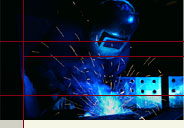
The stock exhaust should be upgraded before any engine modifications. In fact, about the only other thing that should be done before the exhaust is the air intake. Regarding engine performance, always start with the intake and exhaust.
There are several different sections to the exhaust on a z32 twin turbo, all of which can be purchased separately. The first part of the exhaust that should be upgraded is everything downstream from the stock catalytic converters or main "cats." This part of the exhaust includes the mufflers and is called a "cat-back" exhaust, meaning everything that comes after the catalytic converters. A high flow, 2 1/2 inch, stainless steel cat-back exhaust lets the engine breath enough for virtually all bolt-on engine modifications, and is good enough for up to 650 RWHP. Small incremental gains can be made with a three inch cat-back above 650 HP, but the "dollar per horsepower" cost is very high.
Every part of my exhaust including the manifolds and the turbochargers have been upgraded and replaced. My exhaust cost more than most of the cars I have owned in my life, and I've owned a lot of cars. In order, from front to back, the parts of the stock exhaust go like this:
- engine
- exhaust manifolds
- turbochargers
- pre-cats, replaced by downpipes
- mid-pipes with main cats; or test pipes
- mufflers and tailpipes; or aftermarket "cat-back"
The engine is part of the exhaust, starting with the exhaust cycle of the pistons pushing spent gases through the exhaust valves.
Until around late 2007, the exhaust manifolds on a z32 twin turbo were the hardest part to improve upon, mainly because of their tight fit. Then these cast pieces started appearing on the market. Now, they are simply one of the most expensive pieces to replace. I have a pair of Mike Smith exhaust manifolds that were Jet Hot coated, which set me back well over a thousand bucks. The price has come way down with some Chinese knock-offs, but the quality may be suspect.
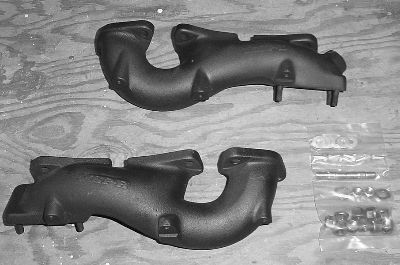 These are my original Mike Smith manifolds, Jet Hot 2000 coated. These are my original Mike Smith manifolds, Jet Hot 2000 coated.
Next in line, the turbo chargers are part of, and driven by what would otherwise be the wasted energy of the exhaust gases. That is the genius of turbochargers. The create power passively from the flow of spent exhaust. I have a pair of JWT 530 BB turbochargers that replaced my stock, smaller, thrust bearing turbochargers. Turbochargers create positive pressure during acceleration at the intake manifold, instead of the vacuum pressure found in normally aspirated engines.
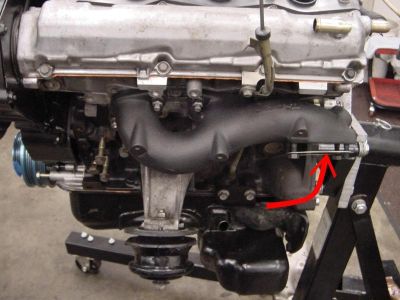 Here is the driver side exhaust manifold, installed. The turbocharger will bolt onto the end of the manifold at the red arrow. Then the downpipe will bolt onto the turbocharger. Here is the driver side exhaust manifold, installed. The turbocharger will bolt onto the end of the manifold at the red arrow. Then the downpipe will bolt onto the turbocharger.
The front of the engine is to the left. My blue underdrive crank pulley is partially in view.
Pre-cats are small catalytic converters that should be replaced by downpipes. Downpipes do not contain any catalytic material. Z's still pass inspection fine without their pre-cats. Pre-cats are one of the most, if not the most, restrictive component of a stock exhaust.
If the main catalytic converters are completely eliminated and replaced with plain pipes then they are called "test pipes" by convention. These are not street legal but people run them and swap them out with cats at inspection time. My exhaust is visually street legal and uses high flow cats. I ran test pipes for awhile but decided not to deal with the hassle of crawling around under my car and swapping them in and out around inspection time. A shop will not swap the parts for you since the test pipes are not street legal.
The piping, mufflers and tailpipes come after the main catalytic converters. These sections downstream from the main cats are referred to collectively, and replaced by an aftermarket "cat-back" system which has bigger pipe diameter and less restrictive mufflers. Aftermarket exhausts are usually noticeably louder than stock.
I ended up spending more on this exhaust system than I spent on most cars when I was growing up, lolam.
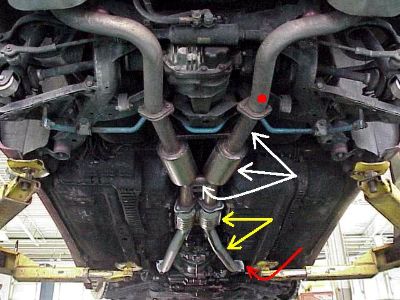 Here is a diagram of my aftermarket exhaust, with all the sections explained below. The rear of the car is closest in the pic. Here is a diagram of my aftermarket exhaust, with all the sections explained below. The rear of the car is closest in the pic.
The diameter of the piping at the downpipes and midpipes is three inches. The cat back is 2 1/2 inches. The stock exhaust was a little less than 2 1/2 inches and a lot more restrictive.
The z32 has a true, dual exhaust, so the two sides of the exhaust are mirror images. Hidden in the very front, up inside the engine bay are the pre-cats, which are bolted onto the turbochargers on one end, and attached to the mid-pipes on the other end. The start of one of the midpipes is shown at the curved red arrow.
The pre-cats' job is to control emissions while the car is warming up. The car will pass emissions testing without the pre-cats, as long as the main catalytic converters are retained.
Below are the stock pre-cats. They look very clunky. Pre-cats have right angle bends that are not conducive to good exhaust flow. The red arrow is pointing at the oxygen sensor. Each pre-cat has one oxygen sensor. I already removed the oxygen sensor from the top pre-cat.
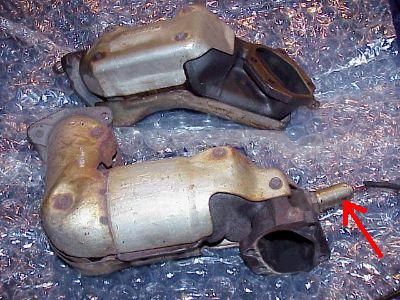
Here are the 4-bolt downpipes that originally replaced my pre-cats. Just by looking at them it's easy to see how the exhaust flow would be improved. These downpipes are "divorced" style, meaning there are two separate openings at the end that bolts onto the turbo charger. The smaller hole is for the turbocharger wastegate, the larger hole is for the exhaust. That's right, the exhaust for each half the engine has to fit through a hole roughly the the size of a half-dollar
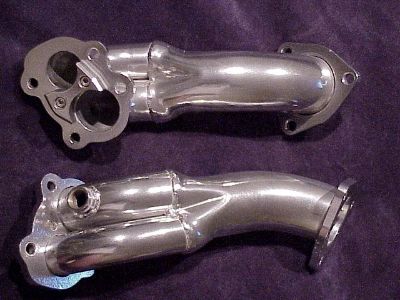 The small round hole on the bottom downpipe is the threaded bung hole for the oxygen sensor. I had my downpipes treated and coated with Jet Hot Sterling, for heat retention and longevity. The small round hole on the bottom downpipe is the threaded bung hole for the oxygen sensor. I had my downpipes treated and coated with Jet Hot Sterling, for heat retention and longevity.
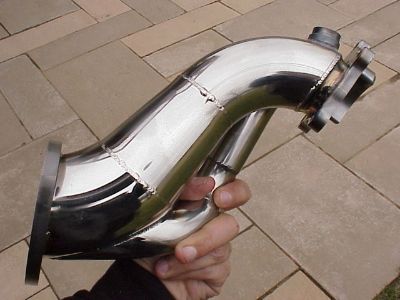 I later upgraded to these Dupree 3", super split, stainless steel downpipes. There is a separate page just for the different types of downpipes. I later upgraded to these Dupree 3", super split, stainless steel downpipes. There is a separate page just for the different types of downpipes.
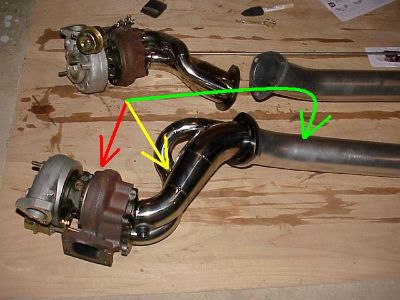 Here is a pic showing the relationship between the turbocharger (red), downpipe (yellow) and midpipe (green). Here is a pic showing the relationship between the turbocharger (red), downpipe (yellow) and midpipe (green).
The turbos and downpipes are very hard to see after they are installed in the car.
 Back to the same diagram, after the downpipe the yellow arrows point to the midpipe. The bulge shown next to the second yellow arrow is the high- flow catalytic converter or cat. Back to the same diagram, after the downpipe the yellow arrows point to the midpipe. The bulge shown next to the second yellow arrow is the high- flow catalytic converter or cat.
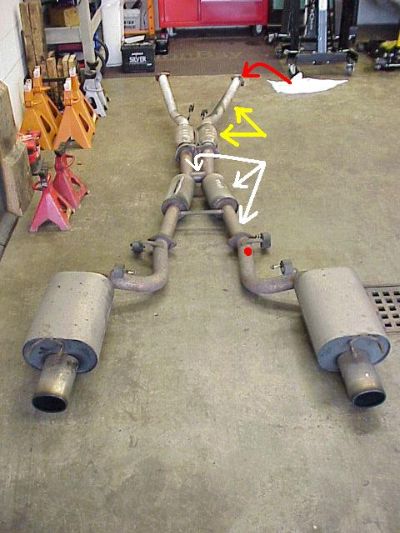 Here is the same aftermarket exhaust removed from my car. The pic above and here are mirror images, including the same colored arrows pointing to the same pieces. The exhaust manifolds, downpipes, and midpipes were all upgraded at this time during my first engine pull. Here is the same aftermarket exhaust removed from my car. The pic above and here are mirror images, including the same colored arrows pointing to the same pieces. The exhaust manifolds, downpipes, and midpipes were all upgraded at this time during my first engine pull.
Continuing down the exhaust, the white arrows point to the beginning of the stainless steel, high flow, "cat-back" exhaust system, which includes everything that is downstream from the catalytic converters. The curved white arrow points to the "H-pipe," which is the only connection between the two halves of what is truly a dual exhaust. This connection supposedly "balances" the exhaust pressure in the two halves of the system. The middle white arrow point to a round cylinder called a "resonator." This part is optional, and is there only for loudness control. However, without resonators the exhaust can have a less desirable raspy sound, IMHO. Resonators make the exhaust note deeper.
Test pipes (no cats) are not street legal, but folks often swap in mid-pipes with cats for their test pipes at the time of state inspection. I had test pipes at one time, but the high-flow cats perform just as well, without the hassle of swapping the test pipes in and out. My exhaust also sounded deeper and less raspy WITH the cats. The price of catalytic converters soared around 2007, so they add significant expense to the midpipes.
By convention, if there aren't any cats, then the midpipes are called "test pipes." These midpipes below have rudimentary high flow cats that will pass a visual emissions test but not much else. The cats are the short bulges on the right ends of the tubes. These three inch midpipes replaced my smaller 2.5" midpipes in the above pic next to the yellow arrows.
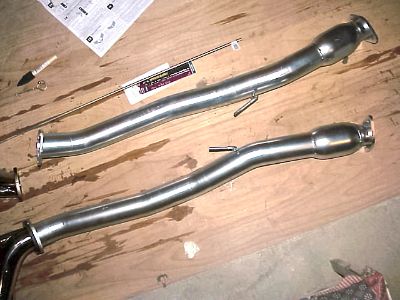 I am now running these 3" aftermarket midpipes with short high flow cats that will not pass an emissions sniffer test, but will pass a visual. The cats are the bulges in the pipes. I am now running these 3" aftermarket midpipes with short high flow cats that will not pass an emissions sniffer test, but will pass a visual. The cats are the bulges in the pipes.
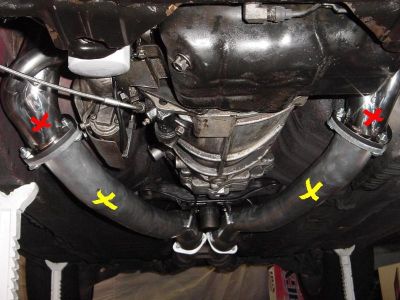 Here is from the front of the car, looking toward the rear. The shiny 3" downpipes with red X's and partially hidden, and bolted to the 3" midpipes with the yellow X's. Here is from the front of the car, looking toward the rear. The shiny 3" downpipes with red X's and partially hidden, and bolted to the 3" midpipes with the yellow X's.
Why not go three-inch for the entire exhaust, and not just the DP's and MP's? Dyno testing by Greg Dupree suggested that a three-inch cat-back only gained six RWHP at the 650 HP level or above. Since very few Z's in the world are making > 650 HP, that small gain was not worth my getting rid of a perfectly good "collectable" (no longer made) JWT SS 2.5" catback exhaust.
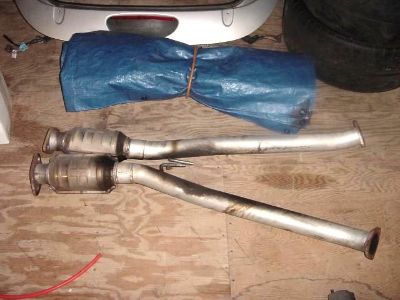 My older 2.5" aftermarket midpipes with larger high flow cats that would reportedly pass an emissions sniffer test. My older 2.5" aftermarket midpipes with larger high flow cats that would reportedly pass an emissions sniffer test.
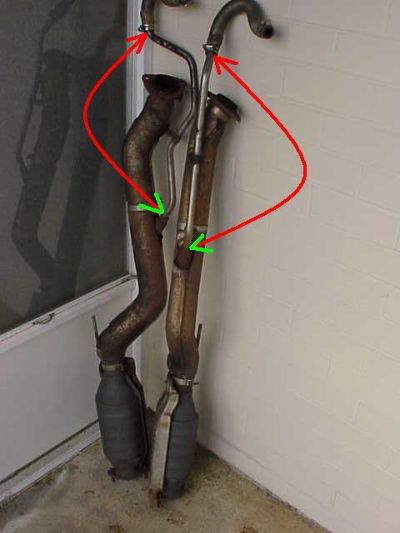 Just for comparison, these are the original OEM stock midpipes with cats and the AIV tubes still attached. I sold these to a guy who wanted to keep his car as close to stock as possible. Just for comparison, these are the original OEM stock midpipes with cats and the AIV tubes still attached. I sold these to a guy who wanted to keep his car as close to stock as possible.
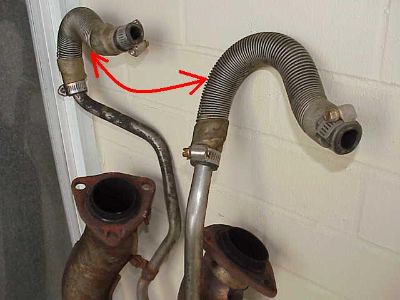 These rubber hoses were wrapped in wire, and attached to the AIV metal tubes that came out from under the car, behind the front fenders. These rubber hoses were wrapped in wire, and attached to the AIV metal tubes that came out from under the car, behind the front fenders.
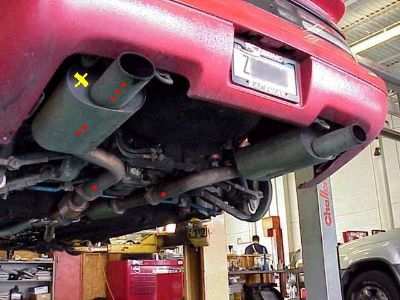 This is a Jim Wolf Technologies (JWT) stainless steel catback exhaust with oval tips. This is a Jim Wolf Technologies (JWT) stainless steel catback exhaust with oval tips.
This exhaust was considered to be one of the quietest on the market, although noticeably louder than stock. The mufflers are stamped Genie brand.
I guess my catback is a collector's item since JWT stopped offering the exhaust for sale. The double red dots are on the mufflers, and the triple red dots are on the oval tailpipe tips that screwed on and covered the round tailpipes that were welded onto the mufflers themselves.
The yellow X is the back face of the muffler can that I spray painted flat black. The whole car was dirty when I took these pics, but painting the cans black like that made the mufflers disappear underneath the car more, which was what I wanted. I like the look of just a couple of oval tailpipes coming out the back without any bling.
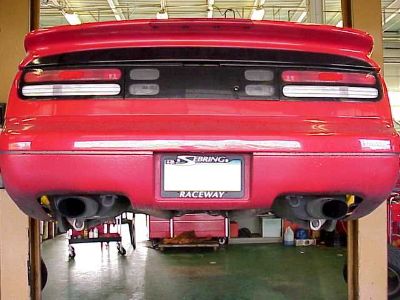
My exhaust yields a nice civilized rumble. The true sound of the exhaust took several months to "mature," and changed noticably over time, for the better. The high flow cats improved the sound, I guess they sort of acted as an extra pair of resonators. When I had straight test pipes without cats the exhaust sounded a lot more raspy.
The exhaust note with my JWT 530 BB turbos, 3" DPs and midpipes is very aggressive. Relatively quiet at cruise, loud but not obnoxious at WOT (wide open throttle).
All exhaust piping should be mandrel bent. Mandrel bending on the pipe means the inner diameter of the pipe was preserved without any crimping. Non-mandrel bending can decrease the cross sectional area of the pipe by as much as 40 percent. This gets back to physics, which states that the flow through a pipe is inversely related to the FOURTH power of the radius (Poiseuille’s equation). This means very small changes in the diameter of the pipe can significantly impede flow. Another consideration is that every right angle bend creates extra resistance roughly equivalent to 15 feet of straight pipe. All these rules add up to exhaust design being very critical if the gases are going to flow efficiently.
As the pictures show, I don't try to keep my exhaust clean. Heck, I don't do a very good job of keeping my car clean, sometimes. Exhaust, like tires, ain't supposed to be pretty, IMHO.
There it is, an aftermarket z32 exhaust from fore to aft. Remember, for performance start with intake and exhaust, intake and exhaust, intake and exhaust . . .
| 